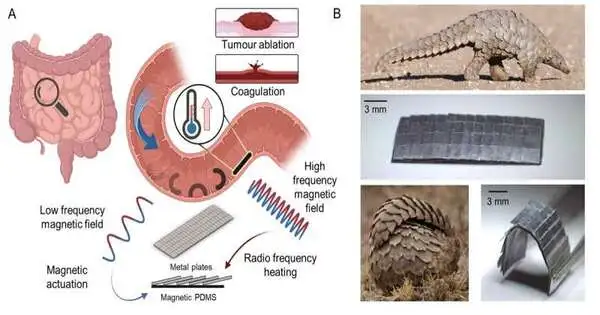The pangolin is a fascinating animal. Because it is the only mammal with hard scales covering its entire body, this animal has the appearance of a walking pine cone. Keratin, like our hair and nails, makes up the scales. The scales overlap and are connected to the soft skin beneath them. In the event of danger, the animals are able to curl up into a ball thanks to this unique arrangement.
The ability of pangolins to quickly curl up their scale-covered bodies fascinated researchers from the Physical Intelligence Department at the Max Planck Institute for Intelligent Systems in Stuttgart, despite the fact that pangolins possess a number of other distinctive characteristics. They used the animal as a model and made a flexible robot out of soft and hard parts that, like the animal, can turn into a sphere in a split second. The robot also has the ability to give off heat when it needs to.
A design for a robot with only two centimeters of length and two layers is presented by the researchers in a Nature Communications research paper: a hard component made of metal elements arranged in layers that overlap, and a soft layer made of a polymer studded with tiny magnetic particles. As a result, even though the robot is made of solid metal parts, it can still be used inside a human body because it is soft and flexible.
The robot can be rolled up and moved back and forth as desired by the researchers when it is exposed to a low-frequency magnetic field at the Max Planck Institute for Intelligent Systems in Tübingen. The metal parts don’t hurt the tissue around them and stick out like the animal’s scales. The robot can transport particles like medicines once it is rolled up. It is envisioned that such a small device will eventually traverse our digestive system, for instance.
The built-in metal causes the robot’s temperature to rise to more than 70 degrees Celsius when it is subjected to a high-frequency magnetic field. Several medical procedures make use of thermal energy, such as removing tumor tissue, treating thrombosis, and stopping bleeding. Even though they are made of hard materials like metal and can also produce heat, free-moving, untethered robots are uncommon. As a result, the pangolin robot is regarded as promising for contemporary medicine.

Credit: Max Planck Institute for Intelligent Systems Tübingen
The magneto-untethered pangolin-inspired robot A conceptual illustration of the robot in the small intestine that was inspired by pangolins A low-frequency magnetic field is used to move the robot, and a high-frequency magnetic field is used to heat it remotely. Each individual pangolin’s body is made up of hard keratin scales that overlap. On the right, you can see the robot that was based on this overlapping design. Shutterstock provided the Standard license for the use of the pangolin images. Tübingen It may one day be able to gently and minimally irritate even the smallest and most sensitive parts of the body and deliver heat as needed. That depicts the future. The researchers have already demonstrated in a video that they can flexibly steer the robot through animal tissue and artificial organs.
More information: Nature Communications (2023). www.nature.com/articles/s41467-023-38689-x





